Pioneers of Townsville
A brief history of the women and men who helped shape Townsville as we know it today.
Pioneers
Andrew Ball (1832 to 1894)
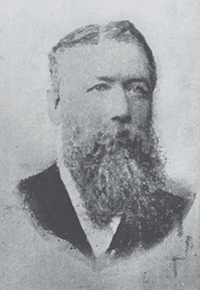
Expedition leader and supporter of early Townsville, Andrew Ball, led an exploration party in 1864 which discovered the site on which the settlement of Townsville was later established.
Andrew Ball led an exploration party in 1864 which discovered the site on which the settlement of Townsville was later established. Ball, a 32-year-old Irishman, was employed by Black & Co. as the manager of Woodstock Station in the hinterland. The company’s General Manager, John Melton Black, sent Ball, along with Mark Watt Reid and a small party of Aborigines, to explore Cleveland Bay with the aim of establishing a port and a boiling-down works. Black believed that a port and industry would ensure the commercial viability of cattle and sheep stations in the hinterland.
Ball’s party reached the mouth of Ross Creek in April 1864. They rode around Castle Hill and approached the creek from the north, eventually setting up camp below the rocky spur of Melton Hill, near the present Customs House on The Strand. After further exploration of the surrounding area, Ball returned to Woodstock and reported the discovery of a favourable site to Black.
Andrew Ball returned to the area in November 1864 as a member of Black’s party, to establish the settlement that would become Townsville. Typically, delays with the supply ship in these initial days saw the settlement on the verge of starvation. The enterprising Ball resorted to sustaining his men on ‘alligator’ eggs.
Castle Hill was named by Andrew Ball. He is also responsible for the settlement’s popular early name, Castletown, chosen for a fancied resemblance to Castletown on the Isle of Man. The settlement’s first newspaper was called the Castletown Times. Ball was a popular early pioneer who remained in the town he helped to establish. He was not especially active in civic affairs, preferring instead to invest in or conduct Townsville businesses and companies. In 1886 he built the family villa residence, Rosebank, which still stands today. Andrew Ball died in Townsville in 1894 and is buried in the West End Cemetery.
- Pioneers Walk – Andrew Ball information sheet (PDF, 847.9 KB)
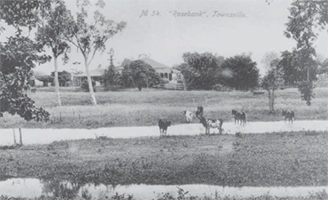
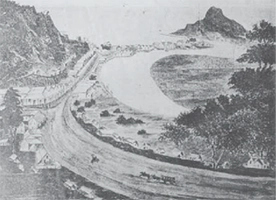
Catherine Robinson (1838 to 1934)
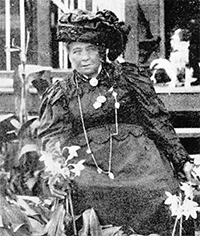
A woman known for her spirit and independence. One of the first European women in the newly created and as-yet-unnamed town, Catherine Colvin was a true Townsville pioneer.
Catherine was born in County Armagh, Ireland in 1838. Catherine and her brother left Ireland for Australia in 1862. She arrived in Brisbane alone, her brother having perished en route. Initially she worked for Lady O’Connor in Brisbane. In June 1865 she arrived in Townsville aboard the SS Policeman to join three other women in work at the Criterion Hotel, then the only structure in town.
While working at the Criterion, she met Heinrich Fredrich Rubinstein (who was later known as Henry Robinson), a German immigrant who had previously worked on the Victorian goldfields. They married at Bowen on 30 November 1865, and began married life at Kissing Point, attempting to set up a vineyard, which failed due to lack of water.
When Robert Towns paid his only known visit to Townsville in early 1866, a trip to Magnetic Island was organised. At Towns’ suggestion the women drew straws, with the result that Catherine became the first white woman known to step ashore on Magnetic Island. Catherine recounted in a 1932 Townsville Daily Bulletin interview, on the occasion of her 94th birthday, how she “readily recalled preparing the tables for a banquet held (at the Criterion Hotel) in February 1866 to celebrate the proclamation of the municipality of Townsville”.
Catherine and Henry’s next move was to a part of Townsville known at the time as Chinese Gardens. Due to Henry’s influence, the area became known as German Gardens, until the name was changed again during World War I, to Belgian Gardens. At German Gardens the Robinsons operated a market garden, before moving out to Ingham Road in 1874, and operating a dairy of 100 head at what is known today as Mount St John. Between 1868 and 1881, Catherine gave birth to ten children, with five surviving to adulthood: Amelia b.1868, Henry b.1872, St John b.1876, Sid b.1877 and Catherine b.1881, with many descendants still living in North Queensland.
Catherine became well known for the dependability of her milk deliveries and her business prospered. She was also known to travel to Woodstock to purchase stock. As business grew she bought numerous properties around Townsville and began earning a large income in rentals. She expanded her property interests by buying in the Halifax area, eventually leasing blocks to cane farmers. The Robinsons ran a hotel in Halifax but apparently Catherine found this disagreeable and returned to Townsville. In 1900, her husband died at Halifax and Catherine lived for many years thereafter with her son St John in Paxton Street, North Ward. She was well known for doing the rounds collecting her rentals and was active until her death in 1934 at 95 years of age.
- Pioneers Walk – Catherine Robinson information sheet (PDF, 1.5 MB)
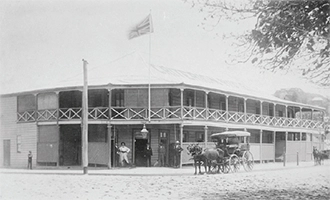
Eddie Mabo (1936 to 1992)
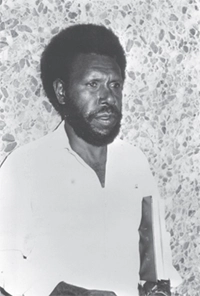
Edward Koiki Mabo was born on 29 June 1936 on Mer (Murray) Island in the Torres Strait. His mother died shortly after his birth and, in accordance with traditional custom, he was adopted by his uncle Benny and aunt Maiga. He moved to mainland Australia in 1957 and in 1959 married Bonita Nehow. Together they raised ten children. Between 1957 and 1967 Mabo worked in various general labouring jobs, and from 1967 to 1975 he was employed as a gardener at James Cook University. His political involvement began in 1962 when he became secretary of the Aboriginal Advancement League. In 1967 Mabo initiated and participated in the seminar We the Australians – What is to Follow the Referendum? which brought together over 300 Indigenous and non-Indigenous participants in an open forum in Townsville to discuss Aboriginal and Torres Strait Islander issues.
In 1973 Mabo and his friend, Burnum Burnum, established the Black Community School in Townsville. Mabo was the Director of the school until its closure in 1985. Between 1970 and 1988 Mabo held a number of positions, including President of the Council for the Rights of Indigenous People, President of the Yumba Meta Housing Association, Director of the Townsville Aboriginal and Islander Housing Cooperative and Vice-Chairman of Magani Malu Kes. He was also involved in a number of national advisory bodies, including the Australian Institute of Aboriginal Studies Education Advisory Committee, and at various times he was employed by organisations who worked with Aboriginal and Torres Strait Islander people.
The Mabo Decision
In 1981, a Land Rights Conference was held at James Cook University at which Eddie Mabo spoke on land ownership/inheritance on Murray Island. A group of Murray Islanders, with Mabo as the leading litigant, decided to take their claim for Native Title to the High Court of Australia.
The claim challenged the legal principle of terra nullius, under which the British treated Australia as a colony of settlement, a land that belonged to no one, and not as a colony of conquest. Therefore, under British Law, all land in Australia had become Crown Land. The case of Mabo and others versus the State of Queensland commenced in the Queensland Supreme Court in May 1982. Over the ensuing eight years, the case sought to determine whether Native Title had existed in Australian law after British colonisation and whether it continued to exist in the present.
The Queensland Supreme Court delivered a judgement on 16 November 1990 and concluded that:
- a form of Native Title had existed prior to European colonisation,
- Native Title was believed by the Islanders to still exist and
- that it was for the High Court of Australia to decide whether Native Title had persisted in Australian Law after British colonisation.
In May 1991, the case was heard in the High Court. On 3 June 1992, the High Court ruled in favour of Mabo and others. This decision overruled the legal doctrine of terra nullius, declaring that:
- Native Title had existed before European colonisation
- Native Title still existed
- that it was up to the Aboriginal and Torres Strait Islander people to determine who owned land.
Eddie Mabo did not hear the High Court ruling. He died of cancer on 21 January 1992, and was buried in Townsville on 1 February 1992. On 18 September 1995 he was reburied at his village, Las, on Murray Island. His gravestone was unveiled on 3 June 1995 and now 3 June is known nationally as Mabo Day.
Mabo was posthumously awarded a Human Rights Award by the Human Rights Commission and an Australian Achiever Medallion by the National Australia Day Council. Eddie Koiki Mabo is widely regarded as one of Australia’s most influential historical figures.
The Sculpture
Commissioned by Townsville City Council to commemorate the Edward Koiki Mabo and the Mabo Decision, this sculpture is part of Townsville City Council’s Pioneers Walk. It was designed and created by artist Matthew Harding with the assistance of Gail Mabo. The features of this sculpture include:
- A pebble mosaic – symbolic of the ancestral Octopus that brought the laws of tradition (Malo) to the people of Torres Strait Islands.
- A Warup drum – an enlarged metal replica of a Warup drum carved by Eddie Mabo. This drum represents the strength and continuum of Eddie’s voice – resonating the connection between the past, present and future.
- A large natural granite boulder – positioned at the centre of the mosaic pattern. Carved into this boulder is a large fingerprint design, symbolising the physical, spiritual and cultural connection between indigenous people and land.
Downloadable:
- Pioneers Walk – Eddie Mabo information sheet (PDF, 224.7 KB)
James Morrill (1824 to 1865)
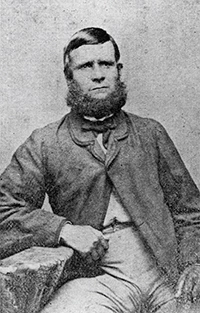
Townsville’s Earliest European Pioneer.
James Morrill, sailor, came from Essex, England. He went to sea at an early age, and was carpenter’s mate in the Peruvian when she left Sydney for China on 27 February, 1846. In a cyclonic gale the barque was wrecked on Horseshoe Reef off the Great Barrier Reef.
Twenty-two survivors took to a hastily-constructed raft, on which they drifted for forty-two days, often coming within sight of land but each time being driven off by contrary winds and tides. Morrill, an active and robust young man, did all he could to preserve the castaways by catching fish and even sharks, which were eaten raw, but despite such efforts only five people eventually survived the landing near Cape Bowling Green.
Of these, Miller, the shipwright, vanished in an attempt to bring rescue by paddling to civilisation in an Aboriginal bark canoe found on the beach. An apprentice boy, White, succumbed to malnourishment not long after the party was discovered by Aboriginals. This left the master of the Peruvian, Captain Pitkethley, his wife and Morrill; they were adopted into communities of wandering Aboriginals, to whose habits of life they soon conformed completely. The Pitkethleys joined a community around Cape Cleveland but were both dead within two years. Morrill lived for seventeen years with a neighbouring community, centred on Mount Elliot and ranging between the Black and Burdekin Rivers. He was fairly well treated and adjusted himself well, but found his superior craftsmanship was useless as the Aboriginals took from him any tools or artefacts which he made himself.
With the opening of North Queensland for pastoral settlement in 1861, Morrill’s isolation was at an end. News of the interlopers was followed by one or two unpromising contacts. A white horseman who murdered a native who was mourning his father was himself speared. But Morrill’s wish to join his own people remained strong; his opportunity came on 25 January 1863 when he and a party of Aboriginals hunting for kangaroo came to an outstation of a sheep property. Overcoming great shyness, Morrill left his companions, washed himself as clean as he could and revealed himself to two astonished station hands with a cry of: ‘Don’t shoot, mates, I’m a British object!’ He was recognised as a white, and his hosts reluctantly parted with him.
Honoured in Brisbane, he was presented at Government House, but did not seem greatly to have interested Governor Sir George Bowen. Appointed to the Department of Customs at Bowen, Morrill returned to North Queensland, where his knowledge and experience of the Aboriginals made him much in demand as interpreter and go-between and often promoted peaceful conciliation. His knowledge of the country and its seasonal variations was often consulted by squatters and explorers. In January 1864 he accompanied George Dalrymple on the expedition to open the port of Cardwell, and in April 1865 he was in charge of the Ariel bringing the first cargo of bonded goods to the settlement on Cleveland Bay which later became Townsville. But his privations during his years of wandering had weakened his health, and on 30 October 1865 he died at Bowen. Aboriginals for many miles around came into town for a memorable mourning ceremony.
Morrill was married in 1864 to Eliza Ann Ross, a domestic servant employed by the police magistrate at Bowen. She remarried after his death, and died at Charters Towers about 1923. They had one son, whose descendants, in 1966, were still living in the Burdekin Delta district of North Queensland.
- Pioneers Walk – James Morrill information sheet (PDF, 1.1 MB)
Joan Innes-Reid (1915 to 2001)

Social Work
Joan was propelled by a desire to meet peoples of other nationalities and in 1938 sailed for Canada and the USA, where she spent the following fifteen years living and working. She completed her Master’s Degree in Social Service Administration at the University of Chicago in 1940.
Joan arrived in Townsville in 1954 as the newly appointed Medical Social Worker for the Townsville General and Cairns Base Hospitals. For the next 8 years Joan travelled extensively as the only social worker servicing the regional communities of North Queensland.
During this time Joan supported and encouraged other women to enter the field of social work and actively advocated the development of regional welfare services and organisations.
Joan Innes-Reid was born in 1915 and grew up in the rural Victorian town of Branxholme before moving to Melbourne. Joan completed her first degree of a Bachelor of Arts, at the University of Melbourne in 1936.
Politics
In 1967 Joan entered politics and became the first woman to be elected to the Townsville City Council. In 1973 she became the city’s first woman deputy mayor. Joan spearheaded many Council innovations including the establishment of child care facilities, access and facilities for disabled persons and promotion of the arts and heritage. Joan returned to academia in 1976 as the first fieldwork lecturer for the newly established social work course at James Cook University. In 1983, the Townsville City Council initiated the “Joan Innes Award” for the most outstanding Social Work Student of the year at James Cook University. Joan has been honoured nationally and regionally, receiving the Order of Australia in 1983 in recognition for service to the community particularly in the fields of local government, social welfare and culture. Joan Innes-Reid became the first woman deputy mayor and was instrumental in establishing community organisations and services.
- Pioneers Walk – Joan Innes-Reid information sheet (PDF, 143.4 KB)
John Melton Black (1830 to 1919)
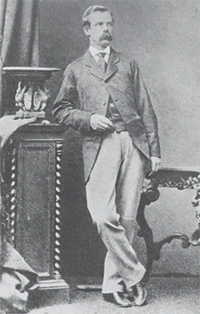
The man with a vision for a thriving port settlement, John Melton Black, is credited with being the “practical” founder of Townsville. Townsville may not have grown to become the “Capital of North Queensland” without this man’s energy, vision, and enterprise.
Black arrived from Scotland in 1852 and joined the Victorian gold rush. In Melbourne, he profited from a successful carrying business servicing the goldfields and also built the first Theatre Royal. Black set his sights on the vast tracts of unsettled lands in North Queensland as an opportunity for pastoral wealth. After establishing in the north, Black recognised the need for a coastal landing place closer to his pastoral leases. He sent his station manager to explore Cleveland Bay for a suitable site for a port. Ross Creek was identified and became the site of Townsville’s early development. Realising the area’s potential, Black, an astute businessman, entered into a partnership with prominent Sydney businessman Robert Towns to secure financial backing for the port and township.
In late 1864, under Black’s management, the first wharf, store and buildings were erected at the mouth of Ross Creek. For the next few years, Black was the driving force behind the new settlement. He worked as the town surveyor, builder, storekeeper, shipping agent, stockman and newspaper editor. When the town was proclaimed a municipality, he became Mayor for the first two terms. Troubled by failing health, the hardships of pioneer life and a strained relationship with Robert Towns, Black returned to Sydney in 1867, selling his share of the business to Towns. Black never returned to Townsville. However, the Townsville community sent him a beautifully designed gold cup which recognised “valuable services in opening up and developing the resources of North Queensland”. Black later married and settled in England. He died in London in 1919 aged 89.
- Pioneers Walk – John Melton Black information sheet (PDF, 860.9 KB)
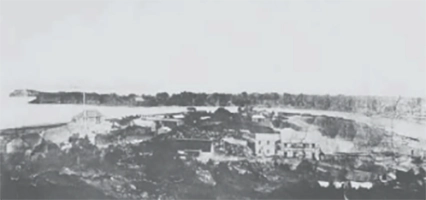
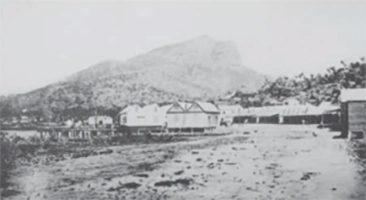
Philip Leong (1917 to 1999)
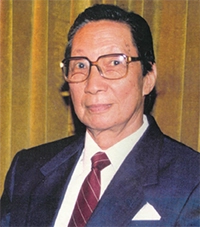
In the 1950s Philip decided to turn the family-run corner store into a self-service shop. Philip’s aim was to provide service to the community in the area in which they lived, given in those days there were very few motor vehicles. He borrowed 10,000 pounds from the Bank of New South Wales to build on the site of what is now the Hermit Park Shopping Centre, opening the self-service supermarket in 1959.
Soon after the Hermit Park renovations began, Philip was offered other shops for takeover. First – Railway Avenue, followed by a store in Oonoonba. At that time there were two grocery food groups from Brisbane operating stores in Townsville – the Manahan Group in Flinders Street, and Barry & Roberts in North Ward. Philip took over both stores in the 1950s. In 1960 Philip opened a second self-service store in Garbutt, then a third in Aitkenvale in 1963. His other shops included Belgian Gardens, Mundingburra, a warehouse in Garbutt and Westside Plaza.
In the late 1960s, Philip saw a need for a shopping centre at Vincent where army personnel were moving. In 1970 he bought the land that would become the first complete shopping centre in Townsville, with a supermarket, 21 speciality shops and a carpark. Vincent Village, as it was called, opened in 1974.
Philip Leong was born in Zhongshan City, Guangdong Province, China, on 25 September 1917. After completing his schooling, he migrated to Australia in 1936, arriving in the port of Townsville where his parents awaited him. His father had migrated to Australia in 1917, and his mother in the early 1930s, and they owned and ran a store on the corner of Ackers Street and Charters Towers Road. In 1944 Philip’s parents retired, leaving the family business to him. The same year Philip also married Edith Lee On, with the union producing five daughters and one son.
In April 1981, Philip sold his business to Woolworths, retaining the premises. Several of the stores carried on trading under his name for many years. Philip then became Managing Director of Philip Leong Investments Pty Ltd and remained involved in the community through business and philanthropy. He was a generous supporter of many community-based organisations.
Philip was awarded a Medal of the Order of Australia in the Australia Day Honours in 1999 for service to the community of Townsville.
Philip died on 18th June, 1999. Following his death, the Philip Leong Youth Programme was established to support young people in the region to pursue ideas or interests in industry or commerce. In 2000, he was named the Townsville Citizen of the 20th Century.
Philip Leong witnessed enormous growth in Townsville, from when he first arrived and the population was around 20,000, to about 120,000 in the mid-1990s. He made a significant contribution to the commercial and economic development of the Townsville region during his lifetime, creating employment for thousands of citizens
- Pioneers Walk – Philip Leong information sheet (PDF, 924.3 KB)
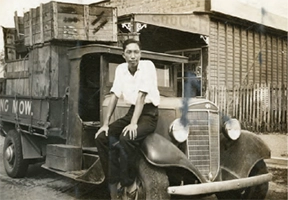
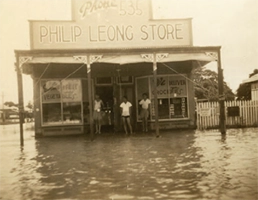
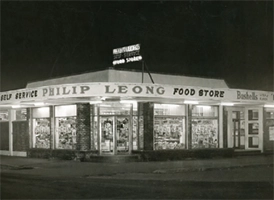
Robert Hayles (1843 to 1926)
Patriarch of a family with a long and proud association with Magnetic Island, Robert Hayles was born 27 December 1843 in London and migrated to Queensland in 1863. By 1898, when he first visited Magnetic Island, he had worked on a sheep run, tried goldmining, owned a hotel, been married twice and produced eleven children. He saw the potential of Magnetic Island as a holiday destination, so he looked for a suitable site for a hotel and bought from George Newman seventeen freehold blocks (four and a half acres) in Picnic Bay in 1899. On part of this he built the first hotel on Magnetic Island.
Designed by architects Tunbridge and Tunbridge, it was a two-storey, wooden building – ‘large and commodious’ with eight bedrooms on the upper floor and on the lower, public and private bars, two bedrooms, a dining room and three parlours. The hotel burned to the ground on the night of Wednesday 21 July 1915. A water well is all that remains of this first hotel, its dancehall and its outhouses.
After building his Magnetic Hotel, Robert Hayles applied in January 1900 for a lease of two acres to construct a jetty, as it was ‘most difficult to land passengers’ and his steamer Bee was ‘of little or no use on account of the danger and difficulty of landing’. In August 1900, Hayles got the lease and built a jetty and ladies' change room. At this time Hayles began a regular ferry service between Townsville and Magnetic Island.
In 1910 Hayles got a special lease for an acre block in front of his existing hotel, on what was part of a recreation reserve on the esplanade. He then built his second hotel on that ideal foreshore site.
In November 1919, eighty-three acres of land at Arcadia, including the guesthouse, were registered to Robert Hayles, his daughter Mary Hislop and his sons Francis, Eustace Robert and Charles. In 1922, the Hayles became Arcadia Limited. In that same year, Hayles Magnetic Island Limited was formed (Magnetic Hotel and the Picnic Bay land became company property) with E R (Bob) Hayles as the first managing director.
Robert Hayles moved to Brisbane but on a visit to Magnetic Island he suffered a stroke and died at Arcadia on 19 August 1926.
Researched and written by Magnetic Island History and Craft Centre Inc. (Magnetic Museum)
- Pioneers Walk – Robert Hayles information sheet (PDF, 1.2 MB)

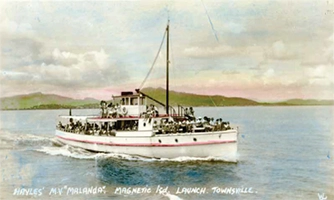
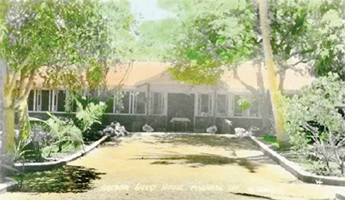
Robert Towns (1794 to 1873)
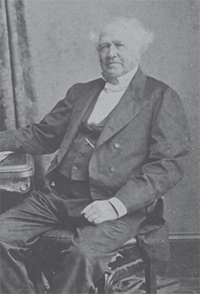
Townsville was officially named in February 1866 after merchant and speculator, Robert Towns. Born in England in 1794, Towns went to sea at an early age and was master of a brig trading throughout the Mediterranean before he was 20. From 1827, Towns sailed between England and Australia in his own vessel, Brothers, with emigrants and general cargo. Settling in Sydney as a mercantile agent, he subsequently acquired his own fleet and wharves at Millers Point.
Towns’ maritime businesses prospered. His ships transported sandalwood from the New Hebrides; whale oil and beche-de-mer from the Pacific; sugar, tea, rice and coffee from Asia; gold-seekers to California; convicts and cheap labour from India and China. His motto was to sail “to Hades and back if there was a profit in it”.
By the mid-1850s, Towns was wealthy and influential – Chairman of the Bank of New South Wales and a NSW Legislative Councillor. Feted by the Sydney business community and government, he flaunted his success with Nautilus, the earliest steam yacht on the Harbour. He then focused on the north.
Towns established Queensland’s first cotton plantation at Logan River. He contracted South Sea Island labourers, bringing several hundred to the colony from 1863. By 1865, Towns’ northern interests totalled a million hectares of pastoral land, 42 holdings in the Kennedy district alone.
He also financed the Cleveland Bay settlement established by partner John Melton Black. Without Towns’ South Sea Islanders their enterprise would have failed. By hand the Islanders removed rocks barring Ross Creek, cleared the mangroves, tilled the plantations and cut the road through Thornton’s Gap, linking the port to the hinterland.
Visiting the area only once in February/March 1866 to inspect the wharf, store, boiling-down works and plantations on Ross Island, Towns wrote: “a most isolated place” and “I never felt so unhappy from home in my life what from bites and blight I have been confined to the house since my arrival here”.
The partnership was dissolved the following year, Towns assuming full responsibility for liabilities. By 1870, with the pastoral recession, he was on the verge of bankruptcy and liquidated his Townsville investments soon afterwards. Towns died at his home, Cranbrook, on 10 April 1873. He was survived by his wife Sophie (née Wentworth), and five children.
Visionary or Villain?
Historians are divided. Industrious, thrifty and merciless described his business philosophy. Paternalistic but well-intentioned has been the judgement on the contract labour issue. Controversy has plagued the name of Robert Towns both during and after his lifetime. Detractors called him “Godfather of the slave trade”. His reputation would have been more substantial without the unfounded rumours of “Blackbirding”.
- Pioneers Walk – Robert Towns information sheet (PDF, 1.6 MB)
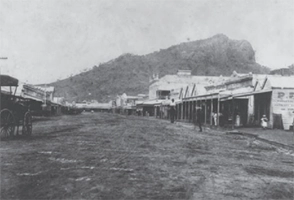
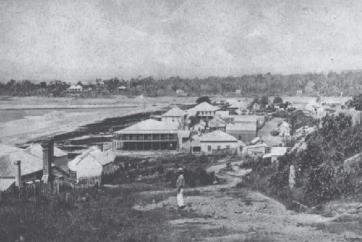
Rose Ball (c. 1840 to 1925)
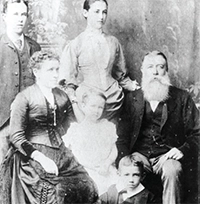
Rose O’Reilly married Edward (Dan) O’Neill, the licensee of the Racecourse Hotel at German Gardens (Belgian Gardens), in Townsville in 1871. The couple had two children before Edward’s untimely death in 1872. Following Edward’s passing, Rose took up the license and transferred it to the Exchange Hotel in Flinders Street East in 1873. Under her management, the Exchange Hotel became a favourite with Townsville’s citizens, almost doubling in size.
In 1877, Rose married Andrew Ball, one of the first European men to explore the site of Townsville. Andrew Ball took over the licence and together they increased the popularity of the hotel, undertaking a number of renovations and extensions. In 1881, the Exchange Hotel and many of the surrounding buildings were destroyed by fire. The Balls rebuilt the hotel, reopening it in 1882.
From 1882 the Balls leased the Exchange Hotel to others but remained active in Townsville’s development. In 1886 they built a house at Mysterton, naming it ‘Rosebank’. Rosebank was known for the beauty of its gardens, with Andrew Ball planting an avenue of mango trees leading to the house. The house and two of the original mango trees still survive. During the depression of the 1890s, Rose managed to hold onto Rosebank. Even after her husband’s death in 1894, she continued to maintain the property. She sold the property to her son-in-law when her daughter Alice married in 1912 and remained at Rosebank until her death in 1925, aged 85 years.
- Pioneers Walk – Rose Ball information sheet (PDF, 1004.9 KB)
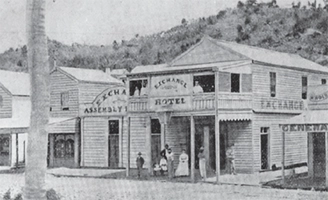
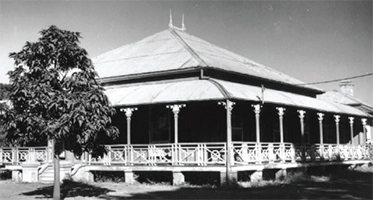
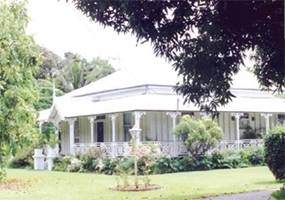
Sister Elizabeth Kenny (1880 to 1952)
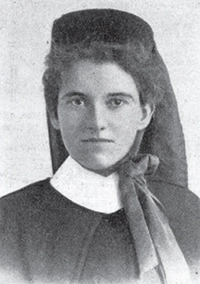
Elizabeth Kenny was born in New South Wales to Mary Moore and Irish farmer Michael Kenny. She received limited education at small primary schools in New South Wales and Queensland. About 1910, Kenny was a self-appointed nurse, working from the family home at Nobby on the Darling Downs, riding on horseback to give her services, without pay, to any who called her. In 1911, she used hot cloth fomentations to treat puzzling new cases, diagnosed as infantile paralysis (poliomyelitis). The patients recovered. Kenny then opened a cottage hospital at Clifton.
During World War I, she was appointed staff nurse in the Australian Army Nursing Service, serving on troop ships bringing wounded soldiers home to Australia. In 1917, she was promoted to Sister, a title she used for the rest of her life. After the war she resumed her home nursing and became the first president of the Nobby chapter of the Country Women’s Association. In 1927, she patented the ‘Sylvia’ ambulance stretcher designed to reduce shock in the transport of injured patients.
In 1932, Sister Kenny established a backyard clinic at Townsville to treat long-term poliomyelitis victims and cerebral palsy patients with hot baths, fomentations, passive movements, the discarding of braces and callipers and the encouragement of active movements. Doctors and masseurs ridiculed her, mainly because they considered her explanations of the lesions at the site of the paralysis bizarre. The controversy raged at a time when there was no vaccination for poliomyelitis. The strong-willed Kenny was opposed by a conservative medical profession, which disagreed with her recommendation to discard immobilisation. Despite almost total medical opposition, parental and political pressure with some medical backing resulted in action by the Queensland government. In 1934, clinics to treat long-term poliomyelitis cases were established in Townsville and later in Brisbane. Kenny clinics in other Queensland cities and interstate followed, and her reputation attracted patients from around Australia and overseas.
Kenny became a heroine in America and was awarded many honours. Her autobiography, And They Shall Walk, was published in 943. In 1946, her story was featured in the film, Sister Kenny. Abraham Fryberg, Queensland director-general of health and medical services, and Thomas Stubbs Brown, orthopaedic specialist, after an overseas visit recommended that treatment based on the Kenny method be used in the early stages of polio.
In 1950, the United States Congress gave her the rare honour of free access to the United States without entry formalities. Despite this success, she remained the centre of controversy, and returned to Australia several times with little acclaim. She retired to Toowoomba in 1951 and died there on 30 November 1952.
- Pioneers Walk – Sister Elizabeth Kenny information sheet (PDF, 729.9 KB)
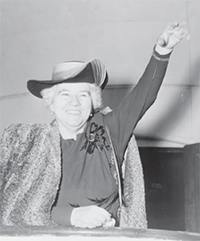
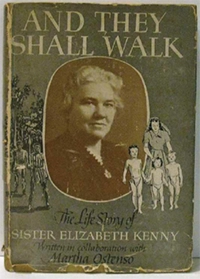
More information
Bibliography of selected South Sea Islander information contained in the collection of Townsville Citylibraries as well as other online sources.
Please note: views expressed in any of the publications do not necessarily reflect those of Townsville City Council.
- Dunbabin, Thomas (1935). Slavers of the South Seas. Book available for viewing at Townsville Citylibraries.
- Docker, Edward Wybergh (1970). The Blackbirders: The Recruiting of South Seas Labour for Queensland 1863-1907. Book available for viewing at Townsville Citylibraries.
- Kennedy, Kett (August 2004). Robert Towns’ Townsville and the “Blackbirding” controversy. Report commissioned for Townsville City Council.
- Lake, Marilyn (2002). Faith Bandler, Gentle Activist. Book available for viewing at Townsville Citylibraries.





